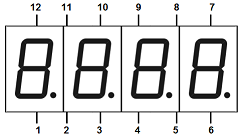-
Notifications
You must be signed in to change notification settings - Fork 65
The digital machine
Monitor a digital pin for incoming pulses and fire a callback or trigger a machine when a pulse is detected. A pulse can be either high or low and must be of a minimum duration. With the pullUp parameter Atm_digital can even be used to handle buttons, switches and dip-switches.

#include <Automaton.h>
Atm_digital pulse;
void pulse_callback( int idx, int v, int up ) {
// Do something when a pulse of at least 20 ms is detected on pin A0
}
void setup() {
pulse.begin( A0, 20 )
.onChange( HIGH, pulse_callback );
}
void loop() {
automaton.run();
}Pin A0 (all analog pins can also function as digital inputs) was chosen so that you can test this with the standard example setup which includes a pot on A0. Turn it up and down to simulate a pulse.
Atm_digital & begin( int attached_pin, int minimum_duration = 20, bool activeLow = false, bool pullUp = false )
Attaches an Atm_digital machine to a pin and sets the minimum duration of pulses to watch for.
pulse.begin( A0, 20 )
.onChange( HIGH, pulse_callback );The activeLow parameter (default false) makes the machine look for a LOW pulse instead of a HIGH pulse. The pullUp parameter (also default false) sets the pin in INPUT_PULLUP mode instead of INPUT.
By using both activeLow and pullUp you can make Atm_digital work just like a simple version of Atm_button, more flexible in some ways, less in others:
pulse.begin( 3, 20, true, true )
.onChange( led, led.EVT_TOGGLE ); // Button on pin 3Registers a callback or machine that gets called when a pulse is detected. The idx parameter (default 0) is passed on as the first parameter of the callback.
pulse.begin( A0, 20 )
.onChange( HIGH, pulse_callback, 5 );Or registers a state machine that gets triggered when a pulse is detected.
pulse.begin( A0, 20 )
.onChange( HIGH, door, door.EVT_OPEN );#include <Automaton.h>
// Declare the state machines
Atm_bit bit;
Atm_digital sw;
void setup() {
// Create a bit machine that (also) controls led 4
bit.begin()
.led( 4 );
// Make the bit follow the status of pin 2 (active low, pullup)
sw.begin( 2, 20, true, true )
.onChange( HIGH, bit, bit.EVT_ON )
.onChange( LOW, bit, bit.EVT_OFF );
}
void loop() {
automaton.run();
}The example above makes the setting of a dip switch (connected to Arduino pin2 and GND) available as a bit state machine. Whenever the dip setting changes, the bit machine will follow. As an extra a led is connected to the bit machine to continually display the status of the (dip) switch.
Use the led() method to assign a pin to be used as an state indicator for the digital machine. The digital machine will control the HIGH/LOW state of the pin to match the state of the digital machine. Use it to control a status led that is linked to the state that the digital machine represents. This way you won't need a separate led machine.
#include <Automaton.h>
Atm_digital sw;
void setup() { // An led on pin 5 reflects the state of a dip-switch on pin 2
sw.begin( 2, 5, true, true )
.led( 5 );
}
void loop() {
automaton.run();
}Note that this example does the same as the example above it, this time with a single state machine component.
To monitor the behavior of this machine you may log state change events to a Stream object like Serial.
Serial.begin( 9600 );
pulse.trace( Serial );